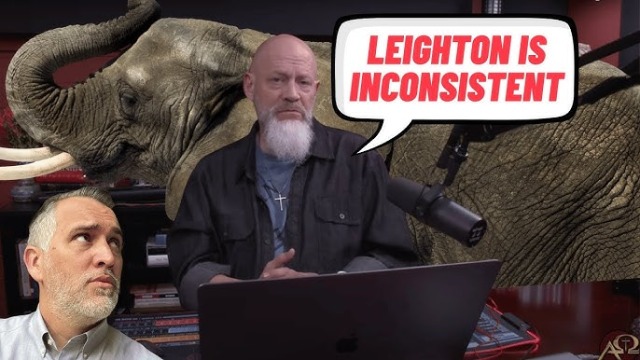
I was listening to James White live today on his Dividing Line vlogcast, and what he reinforces over and over is that he is what some are calling a ‘biblicist,’ or what I would identify as a solo Scriptura or nuda Scriptura proponent, as far as the way that he approaches Scripture. In this way, James White and his archnemeses, Leighton Flowers, ironically affirm the same bibliology and its attending hermeneutic. It is both modern, postEnlightenment, and Lockean (i.e., tabula rasa) in orientation. That is, it sees Scripture and its reception in a historicist frame of reference. This frame leaves the history of interpretation (i.e., creeds, confessions, catechisms etc.) in the dust, in regard to how White and Flowers receive Scripture. This ironically lends itself to a modernist-naturalist appropriation of and engagement with Holy Scripture, insofar that the Bible, in such a frame, seems to be a ‘white-slate’ wherein the interpreter has some type of objectivist angle into its exegesis.
The aforementioned is problematic for a variety of reasons. One prominent reason is that it ends up working from a petitio principii (circular reasoning). That is to say, it presumes: 1) My interpretation just is the objective reading of the Bible, 2) my interpretation of the Bible is a five-point Calvinist reading of the Bible, 3) therefore the objective reading of the Bible just is a five-point Calvinist reading (or just replace five-point Calvinist with Provisionist reading in Flowers’ case). What this approach fails to appreciate, for one, is that nobody approaches Scripture as a presuppositionless blank-slate; human agents are subjects, and as such we bring a variety of preunderstandings and unchecked a priori commitments to theological paradigms as we read Scripture. We could call this the “hermeneutical dilemma.” Neither James White nor his compadre, Leighton Flowers, acknowledge this. And thus, all that they are left to do in their respective debates and correspondences is to sling Scripture right past each other; never critically identifying or checking their theological a prioris at the frontend of their respective readings of Scripture.
But like I was noting, James White, today, as he was talking, in this case about Catholicism, made an absolute distinction between reading Scripture and the history of interpretation of Scripture; as if they inhabit two distinct silos. But they don’t inhabit two distinct silos, instead the history and the biblical exegesis are mutually implicating realities; insofar that human agents are subjectively reading and receiving the text of Holy Scripture. Until White and Flowers can admit this, and until all of their acolytes can come to grasp this, this whole “debate” between them, on five-point Calvinism versus Provisionism, will remain a futile endeavor. Unfortunately, they have many followers, respectively, who they are doing a disservice to. They are teaching young and biologically old, in some cases, Christian hearts and minds to read Scripture rationalistically rather than confessionally (and thus Christologically and Trinitarianly).
In closing, let me refer us to Matthew Levering’s sketch on the Whitean and Flowersian reading of Scripture (viz., what he writes indirectly critiques the Whitean-Flowersian combine of biblical interpretation); as far as its intellectual development and background go. Here Levering also offers an alternative approach that is participatorily grounded in a genuinely christologically and trinitarianly conditioned reading of Holy Scripture.
What happens, then, when Scripture is seen primarily as a linear-historical record of dates and places rather than as a providentially governed (revelatory) conversation with God in which the reader, within the doctrinal and sacramental matrix of the Church, is situated? John Webster points to the disjunction that appears between “history” and “theology” and remarks on the “complex legacy of dualism and nominalism in Western Christian theology, through which the sensible and intelligible relams, history and eternity, were thrust away from each other, and creaturely forms (language, action, institutions) denied any capacity to indicate the presence and activity of the transcendent God.” Similary, Lamb contrasts the signs or concepts that can be grasped by modern exegetical methods with the moral and intellectual virtues that are required for a true participatory knowledge and love the realities expressed by the signs or concepts. Lacking the framework of participatory knowledge and love, biblical exegesis is reduced to what Lamb calls “a ‘comparative textology’ à la Spinoza.” Only participatory knowledge and love, which both ground and flow from the reading practices of the Church, can really attain the biblical realities. As Joseph Ratzinger thus observes, the meaning of Scripture is constituted when
the human word and God’s word work together in the singularity of historical events and the eternity of the everlasting Word which is contemporary in every age. The biblical word comes from a real past. It comes not only from the past, however, but at the same time from the eternity of God and it leads us into God’s eternity, but again along the way through time, to which the past, the present and the future belong.
This Christological theology of history, which depends on a metaphysics of participation inscribed in creation, provides the necessary frame for apprehending the true meaning of biblical texts.
In short, for the patristic-medieval tradition and for those attuned to it today, history (inclusive of the work of historiography) is an individual and communal conversation with the triune God who creates and redeems history—and the Bible situates us in history thus understood. (Levering, 23)